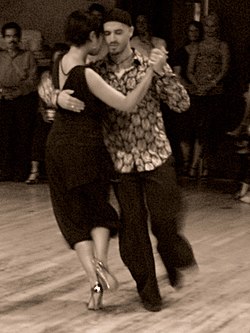This article has multiple issues. Please help improve it or discuss these issues on the talk page . (Learn how and when to remove these messages)
|

Homer Ladas (born 1969) is a contemporary US argentine tango dancer and teacher.
Contents
Homer Ladas is a personality of tango and nuevo [1] in the US. He began dancing tango in 1997 and has taught tango since 1999. His dance style has been influenced by, among others, Gustavo Naveira. Since 2001 he has been dancing with his wife Cristina Ladas (br. January 4, 1973); they were married in 2002. Her tango teachers have included Graciela Gonzalez, Luciana Valle, Guillermina Quiroga. She has danced tango since 1998. Homer and Christina provide a series of original tango instructional videos on YouTube taken at the end of their classes [2] occasionally accompanied with written notes. In 2012 during the New Earth festival in Prague, Homer played his first bandoneon solo and Christina performed aerial silk.